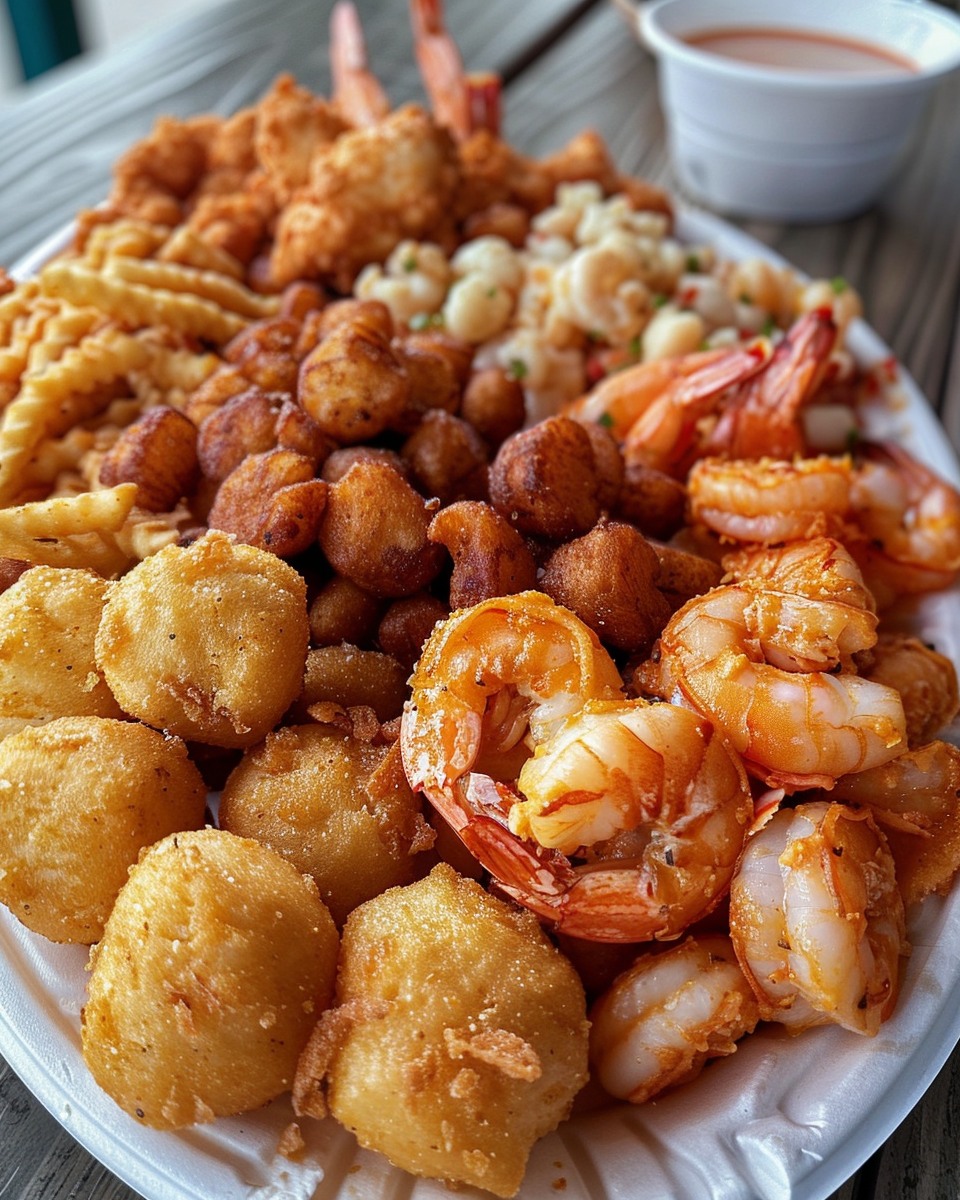Introduction
Overview of a Seafood Platter A seafood platter is the epitome of culinary indulgence, offering a luxurious and shareable dish that brings together a variety of oceanic delights. Whether served at a grand celebration or a casual gathering, seafood platters have become synonymous with coastal regions and seafood-rich cultures worldwide. Their origins can be traced back to the bountiful harvests of coastal communities, where fresh seafood was often served in abundance, symbolizing prosperity and togetherness.
Why a Seafood Platter? The appeal of a seafood platter lies in its versatility. It caters to a broad spectrum of tastes, allowing diners to sample a range of seafood, from the briny sweetness of oysters to the rich, succulent flavors of lobster. This dish is also inherently social, perfect for sharing among friends and family, making it a staple for festive occasions and celebratory feasts. The combination of different seafood types offers a delightful exploration of textures and flavors, with each bite delivering a unique taste of the ocean.
Ingredients
Selecting the Seafood
Shellfish Options: Shellfish form the foundation of any seafood platter, offering a diverse selection of flavors and textures. Popular choices include shrimp, lobster, oysters, mussels, and clams. When selecting fresh shellfish, it’s crucial to look for tightly closed shells and a clean, ocean-like smell, indicating their freshness. Oysters should be plump, with clear, slightly briny liquid inside, while shrimp and lobster should have a firm texture and a mild, fresh scent.
Fish Options: Fish can add variety and depth to a seafood platter, with options like salmon, tuna, or cod bringing rich, buttery flavors. Fresh fish should have firm flesh, bright, clear eyes, and a mild scent. For a visually appealing platter, consider including both raw (sashimi-style) and cooked fish, offering contrasting flavors and textures.
Crustaceans: Crustaceans like crab legs, prawns, and lobster tails are often the stars of the seafood platter. Their sweet, succulent meat is a favorite among seafood lovers. When choosing crustaceans, size can be a significant consideration—larger specimens tend to have more meat, making them ideal for sharing. Opt for live or freshly cooked crustaceans to ensure the best flavor and texture.
Other Seafood Items: To round out your platter, consider adding scallops, squid, or other seafood delicacies. Scallops, with their tender, slightly sweet meat, are a luxurious addition, while squid (calamari) offers a chewy texture that contrasts nicely with the other items. For an extra layer of flavor, you might include cured or smoked items like smoked salmon or ceviche, which bring a tangy, umami-rich element to the platter.
Accompaniments
Dipping Sauces: No seafood platter is complete without an array of dipping sauces. Classic options include cocktail sauce, tartar sauce, mignonette, and garlic butter. Each sauce complements different types of seafood, enhancing their natural flavors. For those who enjoy experimenting, homemade dips can be tailored to personal tastes—try a spicy aioli or a citrusy ponzu sauce for a unique twist.
Garnishes: Garnishes not only add visual appeal but also enhance the flavors of the seafood. Lemon wedges are a must, offering a bright, acidic counterpoint to the richness of the seafood. Fresh herbs like parsley or dill can add a pop of color and freshness, while edible flowers bring a touch of elegance to the presentation.
Side Dishes: To complement the seafood, consider including side dishes like crusty bread, roasted vegetables, or a light salad. These sides can balance the meal, providing a variety of textures and flavors. For a more substantial platter, pair the seafood with carbs like rice or pasta, which can absorb the delicious juices and sauces from the seafood.
Instructions: Step-by-Step
Step 1: Preparation
Cleaning and Prepping Seafood: Properly cleaning and preparing the seafood is essential to ensure its safety and enhance its flavor. Shellfish should be scrubbed under cold water to remove any sand or debris, and any shellfish with open or damaged shells should be discarded. Fish should be scaled, gutted, and filleted if necessary, while crustaceans should be boiled or steamed until just cooked through.
Cooking Methods: Different types of seafood require different cooking techniques to bring out their best flavors. Steaming, grilling, boiling, and poaching are all excellent methods, each offering a unique texture and taste. For example, steaming preserves the natural moisture and flavor of shellfish, while grilling adds a smoky, charred element to fish and crustaceans. Timing and temperature are key—overcooking can lead to tough, dry seafood, so it’s important to cook each item just until done.
Chilling and Serving Raw Seafood: If you’re including raw items like oysters, sashimi, or ceviche, proper preparation and serving are crucial. These items should be kept cold at all times to prevent bacterial growth and maintain their freshness. Serve raw seafood on a bed of crushed ice and consume it promptly to enjoy its delicate, fresh flavors.
Step 2: Assembling the Platter
Arranging the Seafood: A well-arranged seafood platter is as much a feast for the eyes as it is for the palate. Start by grouping similar types of seafood together, layering them for height and visual interest. Larger items like lobster tails or crab legs can serve as the centerpiece, with smaller items like shrimp, oysters, and mussels arranged around them.
Adding Accompaniments and Garnishes: Place sauces, garnishes, and side dishes strategically around the seafood, ensuring they’re easily accessible but don’t overshadow the main ingredients. Balance is key—space out different types of seafood and accompaniments to create a cohesive and inviting presentation.
Final Presentation: For an extra touch of creativity, consider a thematic presentation. A tiered platter can add height and elegance, while a bed of ice can evoke a seaside feel. Decorative elements like seaweed, shells, or edible flowers can enhance the overall aesthetic, making the platter a true showstopper.
Serving Suggestions
Pairing with Beverages
Wine Pairings: Seafood and wine are a match made in culinary heaven. Light, crisp white wines like Sauvignon Blanc, Chardonnay, or Champagne are classic choices that complement the briny, delicate flavors of seafood. Match your wine with the specific seafood—oysters pair beautifully with Champagne, while a rich Chardonnay enhances the sweetness of lobster.
Beer and Cocktails: For a more casual affair, consider pairing your seafood platter with beer or cocktails. Light lagers or citrusy ales work well with the fresh, clean flavors of seafood. For cocktails, a Bloody Mary adds a spicy kick, while a citrus-based spritz offers a refreshing counterpoint to the richness of the seafood.
Non-Alcoholic Options: Non-drinkers need not miss out—sparkling water with a twist of lemon or herbal iced teas make excellent companions to a seafood platter. These beverages cleanse the palate between bites, allowing the subtle flavors of the seafood to shine.
Serving for Different Occasions
Casual Gatherings: For a relaxed, family-style seafood platter, focus on simplicity. Choose a mix of easy-to-eat items like shrimp, mussels, and crab legs, and keep the accompaniments light and informal. Portion sizes can be adjusted to suit the number of guests, making it easy to scale up or down depending on the occasion.
Formal Dinners: To elevate your seafood platter for a more formal setting, consider incorporating gourmet items like caviar or truffle-infused sauces. The presentation should be elegant and refined, with careful attention to detail in the arrangement and garnishing.
Accompaniments and Sides
Light Sides: Pair your seafood with fresh, simple sides like salads, steamed vegetables, or grilled asparagus. These sides complement the seafood without overwhelming it, allowing the natural flavors of the seafood to remain the focus of the meal.
Hearty Sides: For a more filling dish, serve the seafood with richer sides like garlic butter pasta, creamy risotto, or roasted potatoes. These hearty sides add substance to the meal, making it suitable for a main course.
Thematic Variations
Regional Inspirations: Consider creating a themed seafood platter based on regional cuisine. A Mediterranean platter might feature grilled octopus, olives, and hummus, while a New England-inspired platter could include lobster, clams, and corn on the cob. Asian Fusion could bring together sushi, tempura, and spicy dipping sauces, offering a diverse and exciting culinary experience.
Seasonal Variations: Adjust your seafood selection and accompaniments based on the seasonality and availability of ingredients. Fresh, in-season seafood not only tastes better but is often more sustainable. In summer, opt for lighter, grilled options and fresh salads, while in winter, consider richer, heartier seafood and warm, comforting sides.
Conclusion
Recap of the Recipe Creating a seafood platter is an art that combines fresh, high-quality ingredients with thoughtful preparation and presentation. From selecting the freshest seafood to assembling the platter with care, each step contributes to a dish that is as impressive to look at as it is to eat. Whether served casually or as a centerpiece for a formal dinner, a seafood platter is sure to delight and impress your guests.
Encouragement to Experiment Don’t be afraid to personalize your seafood platter. Experiment with different seafood choices, try out new dipping sauces, and explore creative presentation styles. With endless possibilities, each seafood platter you create can be a unique and memorable experience. Whether you stick to the classics or venture into new culinary territories, the seafood platter offers a delicious canvas for your creativity.

